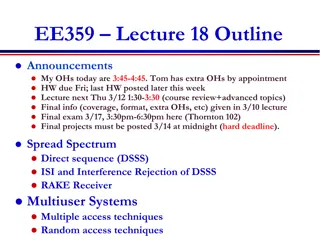
Financial Risk Management Module Overview
Explore the Financial Risk Management Module with Dr. Mesut Tastan for in-depth understanding of international financial markets, derivative products, risk management techniques, and regulatory frameworks. Dive into practical assessments, indicative content, and learning outcomes for a comprehensive learning experience in financial risk management.
Download Presentation

Please find below an Image/Link to download the presentation.
The content on the website is provided AS IS for your information and personal use only. It may not be sold, licensed, or shared on other websites without obtaining consent from the author. If you encounter any issues during the download, it is possible that the publisher has removed the file from their server.
You are allowed to download the files provided on this website for personal or commercial use, subject to the condition that they are used lawfully. All files are the property of their respective owners.
The content on the website is provided AS IS for your information and personal use only. It may not be sold, licensed, or shared on other websites without obtaining consent from the author.
E N D
Presentation Transcript
7FNCE026W Financial Risk Management DR MESUT TASTAN 2019-2020
Practical information Module leader Dr Mesut Tastan: m.tastan@Westminster.ac.uk Office: C394 Office hours: Thursdays 14:00-15:00 Assessment Individual coursework (40%): Submission by 6thDecember (week 12) Final exam (60%): January 2019 Choice of questions (both numerical and essay) Grade and feedback within 3 weeks Mix of lectures, seminars, Excel workshops and independent study
Getting to know each other Module participants Name Background MSc Finance: Banking / International Finance Expectations Ground rules and expectations
Indicative content oIntroduction to international financial markets and risk management oIntroduction to derivative products and markets oVolatility modelling (GARCH and EWMA) oManaging interest rate risk (Asset-Liability Management, interest rate derivatives) oManaging market risk (Value-at-Risk, Expected Shortfall and Simulations) oManaging foreign exchange risk (internal/external techniques, derivatives) oManaging credit risk, operational risk and liquidity risk oRegulatory framework (Basel accords)
Learning outcomes On successful completion of the module students should be able to: oDebate the role of financial markets and institutions in any economy. oChoose an appropriate methodology to successfully manage any exposure to a specific type of financial risk and defend their choice of approach. oDifferentiate between the different sources and types of financial risk and appraise the extent to which a financial institution or corporation may be exposed to each of these. oPropose alternative approaches for the management of financial risk to those already used by an organisation. oMeasure the extent to which a financial institution or corporation complies with relevant regulation. oInvestigate how a specific event in the financial markets might affect their specific organisation.
Lecture 1 Introduction to international financial markets and risk management
Todays content Financial management and risk management International financial markets Types of financial risks Readings: oBessis (2015) chapter 1 oHull (2015) chapters 1 and 5
Financial management Main objective: maximising shareholder value Main decisions: Financing decision (how to raise funds) Liabilities + Equity Investment decision (how to allocate funds) Assets Controlling resources (how to conserve funds)
Financial management includes: Asset management (well-diversified portfolio of assets including low-risk assets) Liability management (acquire funds at the lowest possible cost) Liquidity management (forecast daily need for liquidity) Capital management (keep an adequate level of capital to maintain the appropriate level of solvency) Off-balance sheet management (control exposure derived from financial derivatives) Intrinsically related to risk management
Risk management Risk = perceived uncertainty associated with a particular event Measures of overall risk: Standard deviation ( ) or variance ( 2) of stock prices Standard deviation or variance of net income Standard deviation or variance of ROE and ROA The higher the standard deviation or variance, the greater the risk What is the main problem with such measure of risk?
Exposure to downside risk oRisk managers, and regulators, are only worried about the possibility of a negative outcome downside risk (loss) oThe role of a risk manager is to identify, assess and control the likelihood and consequences of adverse events for the firm (negative consequences on earnings or wealth) oTo assess (measure) such risk for the firm, manager must identify the exposure of the firm to different types of risks oHow much would revenues be affected by a 1% increase in interest rate? A 1% decrease in the GBP? oExposure can be long or short oUncertainty cannot be eliminated but exposure to uncertainty can be reduced oHedging risks can be achieved by taking inverse exposures to long positions oMostly using derivative products
How to manage risk in a portfolio? oInvestors have a portfolio of risky securities (e.g. domestic/foreign stocks, bonds, currencies) oCompanies have a portfolio of risky assets and operations oTwo broad risk management strategies: oRisk decomposition: identify risks one by one and handle each one separately oRisk aggregation: reduce total risk by being well diversified (key component is low correlation between assets)
Trading in financial markets There are two types of markets for trading financial instruments: oExchange-traded markets (Exchanges) oHomogeneous contracts with fixed prices (bid/ask) oMostly electronic trading oE.g. NYSE (US stocks), CBOE (derivatives options) oOver-the-counter markets (OTC) oNetwork of traders who work for financial institutions, large corporations or fund managers oTrading of different products including bonds, foreign currencies and derivatives oParticipants negotiate the terms of the contract oOTC trades are typically much larger than trades in the exchange-traded markets
International financial markets Foreign exchange markets Money markets Derivative markets International financial markets Bond markets Stock markets
Foreign exchange market oAllows for the exchange of one currency for another oAt any point in time, exchange rate between 2 currencies = rate at which one currency can be exchanged for another oExample: https://markets.ft.com/data/currencies oToday, the average daily trading volume in the FX market exceeds $5 trillion (40% of transactions involve USD) oCompared to $600 billion in 1989 and $3 trillion in 2007 oThe system for establishing FX rates has changed over time: oGold Standard Fixed FX rates (Bretton Woods Agreement 1944) Floating FX rates (Since 1973 in many countries) oSpot market vs forward market
International money markets oEach country has a money market whereby surplus units (individuals or institutions with available short-term funds) can transfer funds to deficit units (institutions or individuals in need of funds) oShort-term maturities: one year or less oEurodollars = USD deposited in non-US banks oLIBOR (London Interbank Offer Rate) = interest rate most often charged for short-term loans between banks oExists for different currencies and different maturities: www.wsj.com/mdc/public/page/2_3020- libor.html oShort-term interest rates in a particular currency depend on the supply and demand for that particular currency
International bond markets oFacilitate the flow of funds between borrowers who need long-term funds (companies and governments) and investors who are willing to supply long-term funds (mainly institutional investors) oBorrowers can issue bonds in local or foreign currency oEurobonds = bonds sold in countries other than the country whose currency is used to denominate the bonds oThey are simultaneously placed in many countries o75% denominated in USD widely used by governments/corporations from emerging markets oInternational bonds are subject to several financial risks (for investors): interest rate risk, exchange rate risk, liquidity risk and credit/default risk
International stock markets oCompanies can issue stocks in foreign markets oInvestors can purchase stocks in foreign markets oStock market participation and trading activity are higher in countries with stronger governance oShareholders rights (e.g. voting power) oLegal protection (common law better than civil law) oGovernment enforcement (to avoid corruption) oAccounting laws (e.g. high level of financial disclosure) oInternational investors are subject to market (price) risk, exchange rate risk and country (political) risk
Main stock exchanges (Source: World Federation of Exchanges) 25,000 4,000 3,500 20,000 3,000 2,500 15,000 2,000 10,000 1,500 1,000 5,000 500 0 0 Market Capitalisation (USD billions) Number of listed companies * Amsterdam, Brussels and Paris
Derivative markets Financial derivatives = instrument whose value depends on (or derives from) other more basic market variables Contracts involving rights or obligations relating to purchases or sales of underlying real or financial assets, or relating to payments to be made in respect of movements in indices Rights and obligations derived from the underlying transactions Underlying asset: stock, exchange rate, interest rate, commodity, credit rating, house prices, etc. Main types of derivatives: Futures, Forwards, Options and Swaps Derivatives trade in both types of markets: OTC market: forward, swaps, options Exchange-traded market: futures, options Main transactions using derivatives: Arbitrage, Speculation, Hedging
Types of financial risks Financial risks are defined according to the sources of uncertainty o Main classes of risks: Market Risk Credit Risk Interest Rate Risk Liquidity Risk Foreign Exchange Risk Operational/Technological Risk o Other types of risks: Country/Political Risk Regulatory Risk Reputational Risk
Market Risk Market risk can be defined as the risk of losses in on- and off-balance sheet positions arising from adverse movements in market prices (European Banking Authority) Primary exposures include equities (and other asset prices), but also interest rates, currencies, and commodities High sensitivity to the business environments being operated in These depend on: Global GDP growth Efficient capital markets Inflation Business and investor confidence Geopolitical conditions Business earnings
Credit Risk Potential for loss due to the default or deterioration in credit quality of a counterparty or an issuer of securities or other instruments delay in repayments restructuring of repayments bankruptcy Counterparty risk (default risk) Risk that an organization doesn t pay out on a credit derivative, credit insurance contract, etc. Sovereign risk Risk of a government becoming unwilling or unable to meet its loan obligations, or reneging on loans it guarantees Risk of a downgrade in credit rating increase in credit spread
Interest Rate Risk Interest rate risk = probability of loss due to a change in interest rates Changing interest rates impact both the income statement (net interest margin) and the balance sheet (assets, liabilities and net worth) of financial firms Two types of interest rate risk: Price risk: when interest rates rise, the market value of the bond or asset falls Reinvestment risk: when interest rates fall, the coupon payments on the bond are reinvested at lower rates Interest rates are the price of credit: Demanded by lenders as compensation for the use of borrowed funds
Liquidity Risk Liquidity is defined as the ability of a firm to meet its debt obligations without incurring unacceptably large losses Liquidity risk is broadly defined as the risk of not being able to raise cash when needed oEither through borrowing oOr via asset sales Most of the 2008 bank failures have occurred in large part due to insufficient liquidity oBanks were liquidating assets at a huge discount substantial losses Extreme lack of liquidity results in failure (often in conjunction with other risks)
Foreign Exchange Risk FX risk = probability of loss due to fluctuations of exchange rates Three main types of FX exposure: oTransaction exposure oArises when a company undertakes transactions in a foreign currency oE.g. Importer (exporter) makes (receives) payments in a foreign currency oTranslation (accounting) exposure oArises when a company has assets/liabilities denominated in a currency other than its reporting currency oEconomic (operating) exposure oRisk that the firm s present value of future operating cash flows is affected by changes in exchange rates oCash flows from sales in foreign currency and from foreign operations
Operational Risk Operational risk is defined as the risk of losses stemming from inadequate or failed internal processes, people and systems or from external events (European Banking Authority) includes legal risks excludes reputational risk
Other Risks oPolitical (country) risk is broadly defined as state interference in the operations of a domestic and/or foreign firm (e.g., exchange control regulation or nationalisations) oRegulatory (legal) risk is the potential that unenforceable contracts, lawsuits, or adverse judgments can disrupt or otherwise negatively affect the operations or condition of the firm (e.g. compliance risk) oReputational risk is the potential that negative publicity regarding an institution s business practices, whether true or not, will cause a decline in the customer base, costly litigation, and/or revenue reductions
Next week: Introduction to derivative products and markets






















